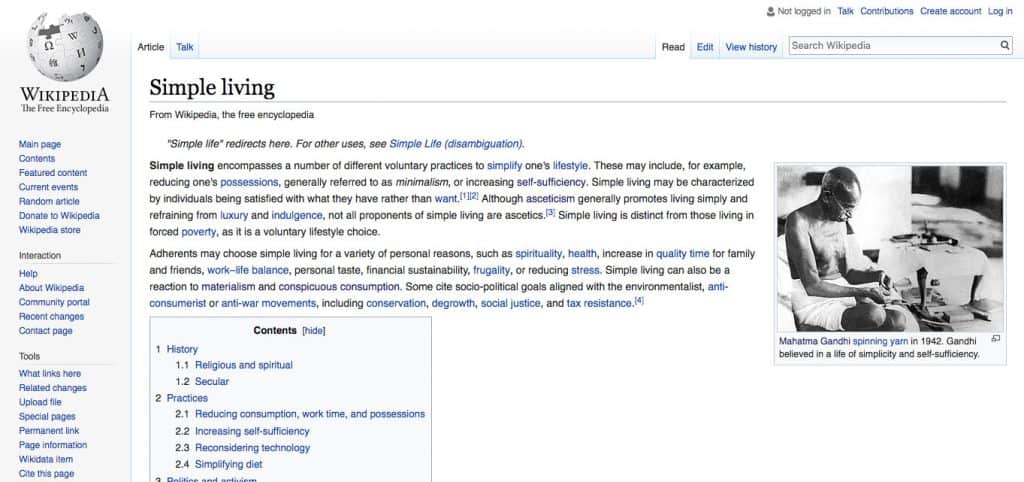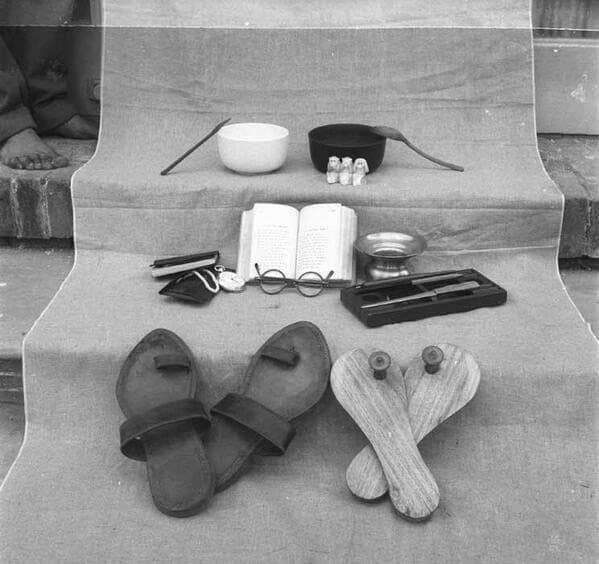
Everyone knows Gandhi from his later years — when he was “Mahatma” which means “great soul” or “the great-souled one.”
But, what path did he follow to get there? Was he born into a lifestyle of simple living, or did he make an intentional choice?
Naturally, I decided to give myself a crash course on Gandhi. You could spend a lifetime studying Gandhi, but I wanted to focus on just a couple aspects of his life:
- What were his early years like?, and
- What was the “Why” behind his personal transformation into simple living?
Gandhi is the Definition of Simple Living
Literally. He’s the lead picture for the definition of “simple living” on Wikipedia:

Gandhi’s Early Years & Transformation
This was the most surprising part of my research. Gandhi was not born into a simple living lifestyle.
He entered an arranged marriage at age 13. Gandhi wasn’t great in school, and he even had a rebellious phase that included smoking and eating meat. His family (mostly his father) guided him to enter the legal profession.
At 18 years old, he went to London to study Law. He dressed in Western clothing but struggled to transition to the culture. However, he did connect with others in the vegetarian movement and became more committed to a meatless diet. Side note: There’s a growing amount of research about the benefits of a mostly plant-based diet (see Blue Zones where people consistently live to over 100 years old).
The “Why” Behind Gandhi’s Personal Transformation
Many people have a “moment of truth” that becomes a defining point in their lives. For me, it was a phase — a six-week existential crisis when I was 30 years old where I questioned everything.
For Gandhi, it was a specific day: June 7, 1893. On that day, Gandhi was 23 years old and on a train heading to Pretoria, South Africa. A white man didn’t approve of Gandhi being in the first-class area even though Gandhi had a ticket. Gandhi refused to move to the back of the train and was forcibly removed and thrown off the train.
His act of civil disobedience awoke in him a determination to devote himself to fighting the ‘deep disease of color prejudice.’ He vowed that night to ‘try, if possible, to root out the disease and suffer hardships in the process.’ From that night forward, the small, unassuming man would grow into a giant force for civil rights. (Source)
In retrospect the journey from Durban to Pretoria struck him as one of the most-creative experiences of his life; it was his moment of truth. Henceforth he would not accept injustice as part of the natural or unnatural order in South Africa; he would defend his dignity as an Indian and as a man. (Source)
It took Gandhi decades to develop his philosophy. Although, he wanted to be clear that “Gandhism” was not something that he believed was a new concept.
There is no such thing as ‘Gandhism,’ and I do not want to leave any sect after me. I do not claim to have originated any new principle or doctrine. I have simply tried in my own way to apply the eternal truths to our daily life and problems…The opinions I have formed and the conclusions I have arrived at are not final. I may change them tomorrow. I have nothing new to teach the world. Truth and nonviolence are as old as the hills. • Gandhi
Gandhi’s Essential Possessions
A quick Google search for Gandhi’s possessions will likely lead you to this image:

There’s even a National Gandhi Museum in India where you can view his final possessions on display as his “worldly remains.” However, some quick research tells me that this was just a select display of his possessions. Someone who has been to the museum said Gandhi had enough possessions to fill about a dozen display cases, but everything he owned was very plain and only the bare essentials.
This brings up an important point about voluntary simplicity, simple living, and minimalism. It doesn’t matter how many things you own. And, it’s not a competition to get below a specific number of worldly possessions. It’s up to each of us to define what simple living and minimalism mean to us. What is a need to one person can be a want to another — and vice versa.
What is Your “Why?”
I extended my research a little bit more to see if Gandhi’s own children were on board with his lifestyle. Of his four kids, it seems like two followed in the path he created. Another did not prescribe to the lifestyle of asceticism but joined some social protests. And, he had a very strained relationship with one of his children.
Your “Why” is yours, and yours alone. I’ll be writing a lot more about creating a life purpose over the next few months, but there’s a Japanese concept called Ikigai to get you started. Not necessarily related to creating purpose, but asking “Why” 5 times can help you get to the root cause of any problem.
If you’ve already had your “moment of truth” and discovered your “Why” or life’s purpose, please share it in the comments!
You may have occasion to possess or use material things, but the secret of life lies in never missing them. • Gandhi
You can follow Sloww via email using the form field below this post or on social media (@SlowwCo) on Twitter, Facebook, Instagram, Pinterest, Medium, Reddit, and Quora.




